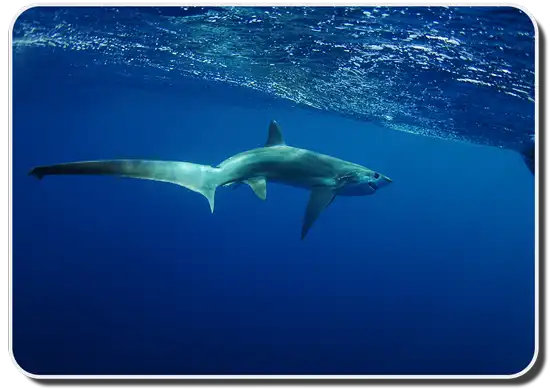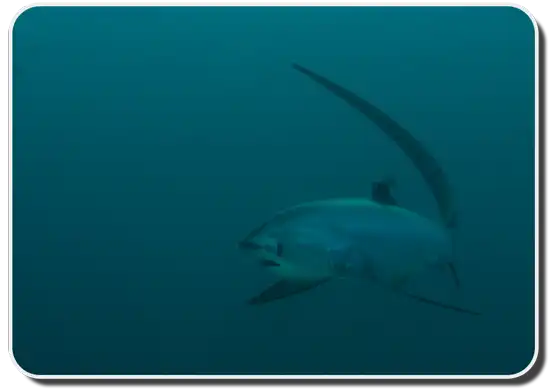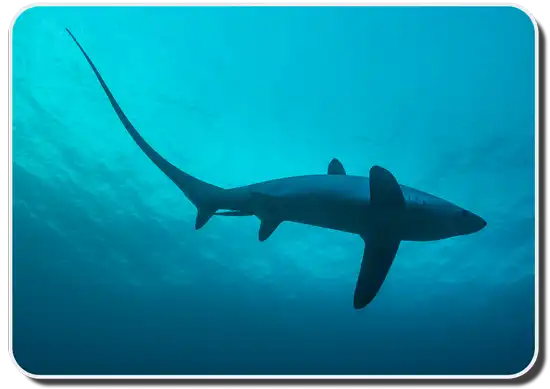The Thresher Shark is also known as the Alopias Vulpinus or Fox Shark. Its name comes from the sharks unusually large tail (caudal fin), which is in most cases, as long as the shark itself!
Today, there are three living species of this Shark:
- Pelagic Thresher
- Bigeye Thresher
- Common Thresher
But experts are still puzzled about the possible existence of a fourth species. This mystery continues to elude enthusiasts, but many believe it’s only a matter of time before this fourth species is confirmed.
It’s origin is also surrounded by mystery. Most likely, the closer relative of the Fox Shark is the Megamouth Shark. Scientific studies are ongoing to try and resolve the many mysteries that surround this unusual and unique fish.

The largest known Thresher Sharks reach a length of more than 6 meters (20ft) and weigh 600 kilograms (216 pounds). Bigeye Threshers are normally the largest with Pelagic Threshers being the smallest.
These are slow growing sharks. They reach their maturity between 8 and 13 years old and live about 22 years. Again, there is quite a bit of mystery here. Some believe this shark is capable of living much longer, but simply hasn’t been verified.
Habitat
Although Thresher Sharks love open and deep waters, they are also found in shallow waters near coastal areas. They are generally not found deeper than 500 meters (1,640ft).
They favor the Pacific and Indian Oceans, especially at the continental shelves of America and Asia. But the exact habitat, again, remains largely a mystery.

Sensory System
In addition to electro receptors that all sharks have, which gives them they ability to detect electrical impulses from living creatures, they also have an extraordinary heat exchanger system. They’re called “endoderms”, which means that they have special thermoregulation. In other words, they produce heat through an internal body mechanism such as enhancing their metabolism and muscle shivering. This is largely a unique feature in Thresher Sharks.

Social Life
For the most part, they are rogue mavericks and remain largely independent. But on occasion, they join together in large groups. This phenomenon has mostly been observed in the Indian Ocean. The reasoning for these get togeathers is currently unknown.
Hunting Behavior
These are very athletic sharks. They are known for slaying their prey with their huge tails and are famous for special jumping techniques and behavior called “breaching” where they jump out of the water and into the air.
While hunting, they launch themselves with their whole body out of the water and perform wild turns. They love to hunt schools of fish in the open Ocean waters and prefer Tuna, Mackerels, and sometimes go after certain breads of Seabirds.
Offspring
As with so many other aspects of this mysterious shark, the reproductive behavior is not well explored. We do know that they are Viviparous, which means that eggs evolve in the uterus until birth.
In general, they give birth to 2 to 5 pups at a time and the pups normally have a length of 120 to 160cm (47 to 63 inches).
There is a special phenomenon called “oophagy” in the womb. The pups actually leave their eggs, still in the womb, and feed themselves with all the unfertilized eggs.
Relationship with Humans
The largest threat to the Thresher Shark is human fishing. Many fisherman catch them for sport, while others catch them for their fins, liver oil, tails, and flesh.
Due to recent population depletion, new laws are being enacted to help protect this species from upsetting the fragile balance of the marine ecosystem, especially since these sharks have a low reproductive rate as compared to other sharks.
This species poses very little threat to humans. The largest threat of injury is divers getting hit with the enormous tail. Attacks of any kind on humans are almost unheard of.
10 Incredible Facts About Thresher Sharks

Thresher Sharks are an incredibly unique species of shark. They have very unusual anatomy, behaviors, and history. Though they are relatively populous, because of their environment, there is very little human interaction. Here are ten incredibly facts about Thresher Sharks:
1. There May Be An Undiscovered Species Of Thresher Sharks: So far, scientists recognize three extant species of Thresher Shark: The Pelagic Thresher, Bigeye Thresher, and the Common Thresher. A species of Thresher Shark was found of the coast of Baja in 1995. After scientific analysis of its DNA, it was found to potentially be a new species of Thresher Shark. These has only been one sample of this potential species found so far.
2. Thresher Sharks Have Very Long Tail Fins: Thresher Sharks have very long upper caudal fins. Thresher Sharks can grow to 19 ft (5.7 m) in length and maturity. Their long tail fin measures half the length of their body. So in adult Thresher Sharks, their tails can be as long as 10 ft (3 m). These long tails give them several unique biological and behavioral capabilities.
3. Thresher Sharks Were Named After Foxes: The first person to ever write about Thresher Sharks was Aristotle in the book Historia Animalia. In it, he claims that Thresher Sharks are able to bite through fishing lines to escape and will temporarily swallow their young to protect them from predators. Both of these behaviors, which are scientifically inaccurate, lead Aristotle to praise the high level of intelligence and cunning of the Thresher Shark, ultimately leading to the name “Alopex.” In Greek, Alopex means fox, which are considered highly intelligent and cunning animals.
4. Thresher Sharks Prefer Deep Open Ocean Waters: Though they breed along the coastal waters and juvenile Thresher Sharks will stay in shallower waters until maturity, Thresher Sharks prefer the deep, open ocean waters. They spend most of their lives at a depth of 1,800 ft (550 m). The migrate the open ocean waters spending the summer in the North and the winter in the South. They prefer tropical and subtropical waters, but will migrate into temperate waters to hunt.
5. Thresher Sharks Are Impressive Hunters: Thresher Sharks are very impressive hunters that tend to prey on schools of fish. They use their unique tails to help trick and lure prey. Once the prey comes close to them, they will then slap the prey with their tail repeatedly until it is disabled. Then it will attack the prey with speed assault, taking bites on each launch until it has completely consumed the prey.
6. Thresher Sharks Are Warm Blooded: Thresher Sharks are one of the few shark species with endothermic capabilities. They have slow-oxidative muscles combined with blood vessel countercurrent exchange which helps them regulate their blood pressure internally. This leads them to have blood that is 3.6°F (2°C) warmer than the surrounding waters. Being warm blooded allows them to stabilize proteins in cooler waters and helps them more efficiently use their muscles. Their endothermic capabilities make them agile hunters and quick swimmers.
7. Thresher Sharks Are Strong Swimmers: Thresher Sharks are strong active swimmers. Thresher Sharks are one of the fastest sharks in the ocean and can swim at a top speed of 30 mph (48.2 kph). They can also jump out of the water, a behavior known as breaching. They are able to swim so fast because of a combination of extra thrust from their long caudal fin, their endothermic capabilities, and the presence of a strip of aerobic red muscle along its flanks that helps give it extra strength and power. Thresher Sharks’ bodies are also torpedo shaped, which reduces the drag of the water against their bodies.
8. Thresher Sharks Are Related To Great White Sharks: Thresher Sharks are Lamniformes, otherwise known as Mackerel Sharks. The Mackerel Shark family includes Basking Sharks, Mako Sharks, and the famous Great White Shark. The Thresher Shark is also related to the prehistoric terror, the Megalodon Shark. These sharks all can regulate their blood temperature, have similar biological features like two dorsal fins, an anal fin, five gill slits, and a mouth that goes past their eyes.
9. Threshers Sharks Are Part Of An Interesting Myth: There’s a long standing myth that Thresher Sharks and Swordfish work together to attack whales. The myth says that the Thresher Shark will swim in front of a Whale and district it by violently whipping its tail around, meanwhile the Swordfish will attack the Whale with its sharp nose, impaling it. Then they share the feast. No one’s really sure why this is a common myth, but it is not true as neither Thresher Sharks nor Swordfish can eat whales.
10. Thresher Sharks Are Not A Threat To Humans: Threshers Sharks are not a threat to humans. There has only be one documented Thresher Shark attack on a person and it was provoked by the individual grabbing the Thresher Shark’s tail. There have been four accounts of Thresher Sharks attacking boats, but were individuals fighting against capture. For the most part, Thresher Sharks are scared of humans and will even swim away the moment they see a diver. On the other hand, humans are a threat to Thresher Sharks. They are often hunted by commercial and recreational fisherman for their unique tails. Since they tend to hunt schooling fish, they are also often a commercial fishing byproduct of tuna. So really, Thresher Sharks are not a threat to humans, but humans are a threat to Thresher Sharks.
Thresher Sharks are an interesting species of shark. They have long tails that make them impressive hunters and fast swimmers, like their illustrious cousins the Great White and Megalodon Sharks. They have a long history with humans, though they are rarely seen, and inspire myths and fascination. If you’d like to learn more about Thresher Sharks check out some of the other great articles on Shark Sider.
